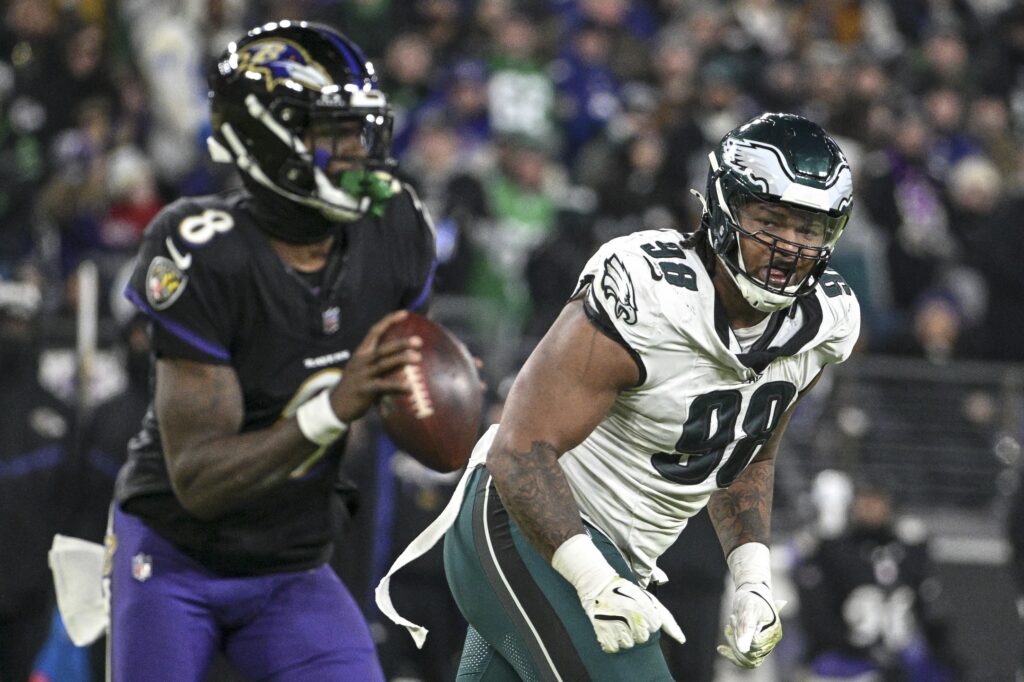Ad Disclosure
Data Backs Up the Narrative that the Eagles aren’t Getting Any Help from the Refs

We wrote a little bit about Jalen Carter on Tuesday, who is being held, grabbed, pulled, tripped, and manhandled on most occasions without penalty flags being thrown.
There’s a narrative floating around out there, a narrative that the Eagles aren’t getting a lot of calls this year, while some ticky tack stuff is being given to opponents. It actually does check out when you look closer at the penalty stats.
A couple of things worth highlighting from the Sportradar data, with help from sites like NFL Penalties and Football Database:
1) accepted penalties: 53
This number is dead last in the NFL. No one has accepted fewer penalties than the Eagles. The Cowboys have accepted the most, at 99, so there’s a difference of 45 accepted penalties separating #1 in the league and #32.
2) declined penalties: 12
This number is close to the NFL median, which means the accepted number isn’t significantly altered by an outlier of declined flags. There are also six offsetting penalties, which is tied for 8th-most in the league but does not swing the larger data significantly.
3) penalty differential: -22
When you take the number of Eagles penalties and factor in the number of opponent penalties, the Eagles are at a double digit negative differential. It’s the second-worst number in the NFL.
4) penalty yard differential: -194
When converting the penalty differential into yards, the Eagles are almost two field lengths behind their opponents. This number is also second-worst in the league.
Ironically, only the Ravens have a worse penalty yardage differential.
One thing that’s important for this statistic is categorizing penalty types. For instance – defensive offside results in a five-yard hit, but the Eagles took some highly-questionable DPI and holding calls in Los Angeles, and those are spot of foul penalties that result sometimes in 20 or 25+ penalty yards against.
5) penalties committed: 74
This number is right in the middle, and leaves the Birds tied at 17th with the Vikings and Lions. What it means is that the differential is less affected by Eagles infractions and more affected by a lack of whistles against the opponent. For comparison, Baltimore has accepted 78 opponent penalties, but committed 105. Their differential is horrendous more because of their own issues.
6) first downs gained by penalty: 16
This is tied for 29th in the league. It does not factor in sequences where the Eagles moved the sticks and declined a penalty at the same time.
7) penalties by unit: special teams 16, offense 38, defense 23
A breakout of which units are getting the most flags. Special teams is an issue, with the fourth-most penalties in the league during punt, kick, and return sequences. The offensive penalties are 24th-most in the league, which is good, and the defense is tied for 23rd, which is also good. Eagles flags are disproportionately coming from Michael Clay’s unit.
Furthermore, Football Database parses out the number of specific penalties each team commits. In 2024, the Eagles have committed 16 false starts, two delays of game, and 11 offensive holding, so that’s the bulk of infractions on the offensive side. The defense is middle of the pack in DPI and holding, seven and six flags, respectively, and as a testament to the team’s overall discipline, the personal foul (0), unnecessary roughness (2), and unsportsmanlike conduct (0) penalties are some of the lowest in the league.
=====
The takeaway is that the Eagles aren’t committing a lot of penalties themselves, but they have huge negative differentials because their opponents are being flagged at a significantly low rate. If you break it out per game, the numbers amount to -1.75 and -16, so opponents are getting almost two fewer flags per game and earning 16 yards in net as a result. It hasn’t stopped the Eagles from ripping off eight wins in a row and improving to 10-2, but it does show that they’re generally fighting an uphill battle against the refs.
Kevin has been writing about Philadelphia sports since 2009. He spent seven years in the CBS 3 sports department and started with the Union during the team's 2010 inaugural season. He went to the academic powerhouses of Boyertown High School and West Virginia University. email - k.kinkead@sportradar.com